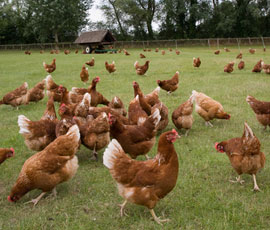Livestock 2012: Poultry addition brings disease challenges

Livestock producers thinking of adding a poultry enterprise to their farm businesses should pay close attention to the disease implications.
Botulism was a particular concern, Mike Clarke of the Minster Veterinary Practice told producers at Livestock 2012.
While there were few symptoms in poultry, chicken carcases in litter posed a serious threat to sheep and cattle if that waste was then spread on pasture.
Erysipelas was another disease that could circulate between species, especially where free-range hens or turkeys were placed on pig farms.
While pigs could easily be treated with antibiotics, the same was less true for poultry. Antibiotics had limited effectiveness if added to drinking water, while injecting adult turkeys had its own problems.
“If you have pigs, I’d advise that you don’t go into poultry production, or at least vaccinate in advance if you do, as if you have an outbreak, there’s not a lot you can do,” said Mr Clark.
Mycoplasma was less of a problem, as the main types affecting poultry – mycoplasma synoviae and mycoplasma gallisepticum – were species specific.
“But if you have a shoot on the farm, then that can be a problem, even if you just put a few pheasant or partridge poults down.”
One of the most common problems on all livestock farms was E coli, but especially for laying hens which were “running out of puff” from 65 weeks.
Mixing free-range hens with cattle was asking for trouble with regards E coli, he said.
And then there was campylobacter – one of the causes of spotty liver syndrome in poultry. Campylobacter, the main source of human food poisoning, was spread by flies, rodents and wild birds and was far more likely to be a problem on mixed farms than on specialist broiler units.
Read more on Livestock 2012
